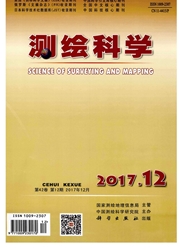

 中文摘要:
中文摘要:
由于全变分(Total Variation,TV)模型具有较好的去噪、增强和扩散等功能,在过去的几十年中,TV模型在图像去噪、增强和超分辨率重建等方面得到了深入研究与广泛应用。鉴于TV模型的理论与分割理论具有一致性,因此本文主要研究TV模型用于高分辨率遥感影像的分割,并针对地物多尺度特征,提出了自适应的TV(ATV)模型;且与目前流行的面向对象的影像分析软件eCognition中的FNEA分割方法进行了比较。实验采用2幅高分辨率遥感影像,同时采用了面向对象的分割和分类评价,得出各方法各具优缺点的结论。
 英文摘要:
英文摘要:
The total variation (TV) model is an effective tool for images processing such as image restoration, enhancement, reconstruction and diffusion techniques. Due to the consistence between the total variation model and the segmentation problem, in this paper, a TV-based segmentation approach was investigated for high spatial resolution remote-sensing imagery. Specifically, an adap- tive TV (ATV) model was proposed considering the multiscale characteristics of objects in high-resolution imagery. In experiments, the proposed TV-based approach was compared with the widely used Fractal Net Evolution Approach (FNEA) that is embedded in the commercial software eCognition.
 同期刊论文项目
同期刊论文项目
 同项目期刊论文
同项目期刊论文
 A multiscale urban complexity index based on 3D wavelet transform for spectral-spatial feature extra
A multiscale urban complexity index based on 3D wavelet transform for spectral-spatial feature extra Object-oriented change detection based on the Kolmogorov-Smirnov test using high-resolution multispe
Object-oriented change detection based on the Kolmogorov-Smirnov test using high-resolution multispe Classification of high-spatial resolution imagery based on distance-weighted Markov random field wit
Classification of high-spatial resolution imagery based on distance-weighted Markov random field wit Recovering missing pixels for Landsat ETM plus SLC-off imagery using multi-temporal regression analy
Recovering missing pixels for Landsat ETM plus SLC-off imagery using multi-temporal regression analy An Adaptive Artificial Immune Network for Supervised Classification of Multi-/Hyperspectral Remote S
An Adaptive Artificial Immune Network for Supervised Classification of Multi-/Hyperspectral Remote S A Kernel-Based Target-Constrained Interference-Minimized Filter for Hyperspectral Sub-Pixel Target D
A Kernel-Based Target-Constrained Interference-Minimized Filter for Hyperspectral Sub-Pixel Target D An Endmember Dissimilarity Constrained Non-Negative Matrix Factorization Method for Hyperspectral Un
An Endmember Dissimilarity Constrained Non-Negative Matrix Factorization Method for Hyperspectral Un A Perceptually Inspired Variational Method for the Uneven Intensity Correction of Remote Sensing Ima
A Perceptually Inspired Variational Method for the Uneven Intensity Correction of Remote Sensing Ima SAR image denoising in nonsubsampled contourlet transform domain based on maximum a posteriori and n
SAR image denoising in nonsubsampled contourlet transform domain based on maximum a posteriori and n A modified stochastic neighbor embedding for multi-feature dimension reduction of remote sensing ima
A modified stochastic neighbor embedding for multi-feature dimension reduction of remote sensing ima 期刊信息
期刊信息
